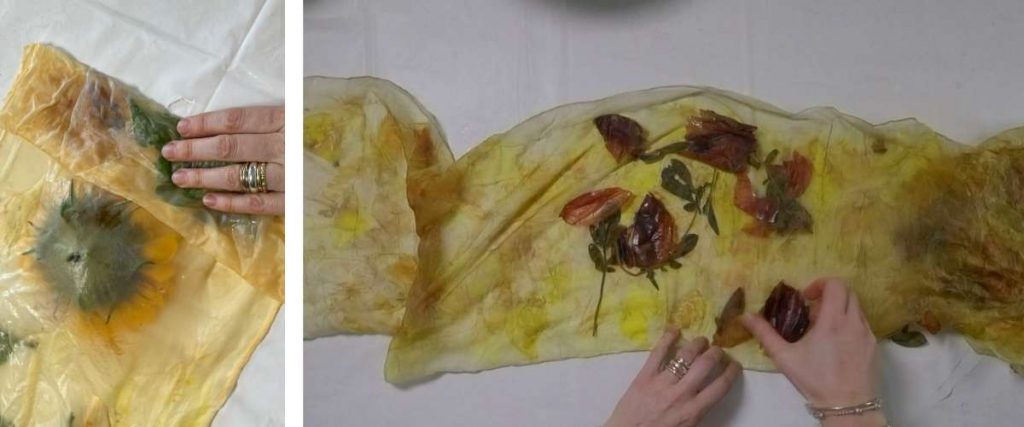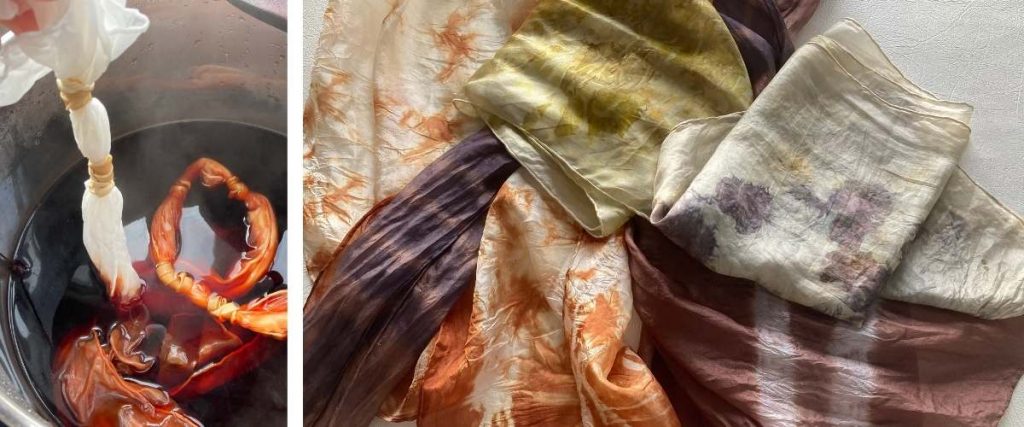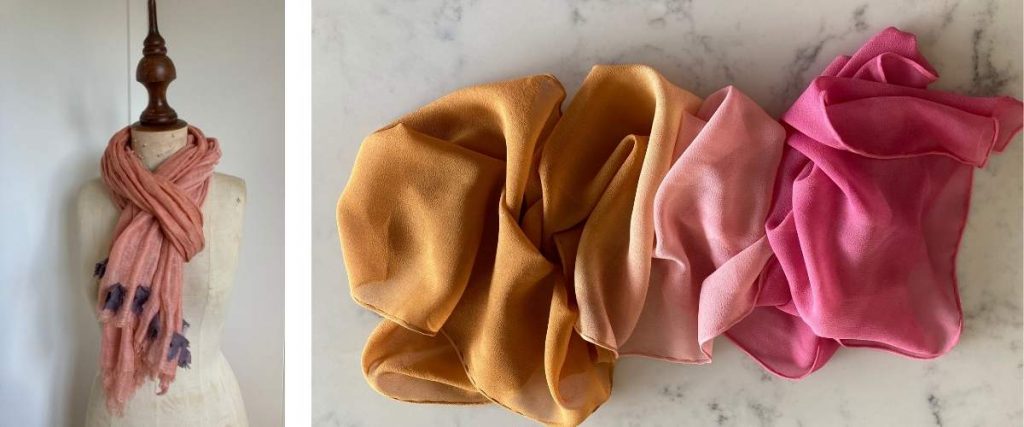Can silk fabric be dyed?
YES! It can! In fact, silk is the best out of all the natural fibers to dye with, in my opinion. You can create different colors using a different dyeing process each time. These include solid color and prints.
Today I want to talk about how to dye silk in different ways to illustrate how versatile and generous silk can be when it comes to natural dyeing.
Of course I love naturally dyeing wool as well but I want to devote this post to the lovely silk fiber!

Silk is a super strong fiber and can resist high temperatures. This is super handy in natural dyeing processes since we normally use the hot dyeing method.
Unlike wool, silk doesn’t felt which makes it a much easier fiber to dye with. It can also be thrown in the washing machine and can withstand cold and hot regular washes.
However, if you go through the effort of lovingly hand dyeing your silks using natural dyes you probably want to hand wash it using gentle delicate laundry soaps :).
But it’s good to know that you won’t brake the fabric in case it ends up in the family laundry pile by accident!
Of course there are some best practices and things you must avoid when dyeing silk (read here).
This post contains affiliate links, which means I receive a small commission, at no extra cost to you, if you make a purchase using this link. Click here to read my full disclosure policy.
How to dye silk fabric at home?
You can easily dye silk at home in a safe and environmentally friendly way by using natural dyes.
There are a few ways in which you can dye silk using natural dyes. These are:
- Hot dyeing method (immersion dyeing)
- Solar dyeing
- Eco printing
- Bundle dyeing
- Hapazome
- Tie dyeing
Hot dyeing method (immersion dyeing)
The most consistent results will come from using the hot dyeing method (immersion dyeing).
You simply follow a formula (8 step process) and you are guaranteed excellent results every time.
Check out the kind of amazing natural color you can dye your silk with:

Most of the fabrics in the photo above are different qualities of silk which will also have an effect on the way the silk takes the dye.
The purple yarn on the left bottom corner is also 100% silk yarn.
The chart illustrates the true colors obtained from the natural dyes but you can also change and modify the original colors by using modifiers such as lemon juice and iron water. So you can carry on creating new colors all the time!
This method of dyeing silk is a great way to discover the true dyes available to us and you can create vivid colors, transform them into darker colors or pastel colors as well.
When using the hot dyeing method, you must follow the steps in the correct order and you also need to use certain natural dyes, not all dyes are equal!
Complete the form below to download the list of the best natural dyes to use when dyeing silk!
Solar dyeing
I love to use the solar dyeing method for my silk fabric scraps and my silk yarns and threads.
The photo below shows a collection of silk fabrics (fabric scraps) that were dyed using this method. I used onion skins, eucalyptus leaves and avocado skins to prepare the solar jars.

Check out the beginners guide to solar dyeing here.
You can overdye silk thread. You can also dye your tapestry, weaving or embroidery silk yarns.
In solar dyeing the sun will do all the work for you. It relies on the sun as the heat source to activate the mordanting solution, the dyes and the silk inside the jars or glass bowl.
So you start with cold water which will turn into warm water through the exposure to sunlight.

Eco printing
Eco printing produces the most amazing botanical prints on silks. It’s a super versatile technique because its very experimental and based on the flowers and leaves available depending on the season of year.
You can get really defined prints with this technique and you can also modify the natural dyes and colors by using natural dyes and iron blankets.
These are prints on silk satin. The silk was mordanted and prepared before making the prints.
You can print in many different ways. The photo below shows you a straight forward print without any enhancements or modifiers.

These handbags are made out of eco printed silk which was modified using an iron blanket.

This DIY purse was made out of a color blanket with cochineal.

Bundle dyeing
Bundle dyeing follows similar principles to eco printing but it’s more free and produces more random results 🙂
These silk scarves are 100% silk habotai. You can learn how to bundle dye using iron water here.


Bundle dyeing on silk is a very satisfying process and one that I often teach in my live workshops as well. It’s quick and it never disappoints my students!
The good thing about this method is that you can substitute the use of alum mordant for white vinegar.
How to dye silk with flowers? Hapazome
Hapazome or flower pounding is super fun to get kids involved in dyeing their own silks. You don’t need to prepare the fabric previously and there is no process to fix the dye either.

This method relies on pounding specific flowers (which have good natural dyeing properties) onto a piece of silk using a hammer.
The results are instant but the color is fugitive which means that it will fade away with time.
Tie Dyeing
Tie dyeing is so much fun! By creating a resist area in the fabric through the use of rubber bands or clamps, you can create beautiful patterns.
Check out this shibori tutorial using different tie dye techniques. For best results I like to tie dye with silk but a lot of people use resist dyeing with cotton.
These tie dyed silk scarves were created for the Tie Dye Guide. you can check it out here!


What silk is best for dyeing?
There are 3 main types of silk:
- Mulberry silk
- Eri silk
- Tussah silk (also spelled as tussah, tushar, tassar, tussore, tussur, or tusser)
Mulberry silk is the most common silk and it represents around 80% of the worldwide silk trade. The worms that produce this type of silk are fed with mulberry leaves.
Eri silk is also known as “Peace Silk” because the worms are harvested in a friendly way (not boiled).
Tussah silk is made by silk worms which are fed on oak leaves and it has a rougher texture to it. Also called raw silk or wild silk.
In my opinion these are the best silks for dyeing:
- Pongee
- Habotai
- Silk satin
- Dupion
- Tussah
How to dye silk scarves?
Dyeing silk scarves is a great way to either have a small profitable craft business or make amazing unique gifts.

Check out this post to discover the many ways you can dye a silk scarf.

How to dye silk thread?
Dyeing silk thread is super easy. As mentioned before you can either use the hot dyeing method for dyeing big quantities or the solar dyeing jars for smaller quantities of thread and yarn.
The purple yarns in the photo below were dyed using logwood dye. The yarn in the right is 100% silk and the other 2 purple yarns are 50% silk and 50% cotton.

How to dye silk black?
The easiest way to get natural black color is with the use of natural modifiers such as iron water.
Check out how easy it is to dye silk using acorns and then turn the golden silk into black with an after dye process.

Materials and equipment to dye silk
Here is a quick list of things you would need to dye silk using natural dyes.
Each of the methods above are linked to detailed tutorials in which you will find more specific materials list.
However this is a good general list of items to have at hand if you are considering silk dyeing with natural dyes:
- Silk fabric (I love habotai and silk satin)
- Silk scarf
- Alum (mordant)
- White vinegar
- Rubber gloves
- Dye pot
- Plastic bowls
- Plastic buckets
- Mild soap
- Glass jars or glass bowls
- Fabric dye (natural dyes)
- Dyes assists such as citric acid, soda ash
Note: Always wear use gloves and for best results follow the steps and the formulas provided in each of the tutorials.
Other types of dyes
You can easily dye silk using food coloring as well as synthetic dyes, reactive dyes and procion mx dyes which would also dye any synthetic fibers.
However, I like to stick to natural practices and I love dyeing natural fibers such as protein fibers (silk and wool).
I hope you have enjoyed this post! Reach out should you have any questions!
Save this post to your favorite Pinterest board!

Also, dyeing silk with tea dye is a wonderful way of using food dyes. It will give you a rich brown color that it’s hard to get with any other natural dye!


Thank you so much for just the encouragement I needed 😁
Thats so cool Tamara! I am happy and excited for you!
Hello, thanks for all the information. I’m very interested in silk dyeing and didn’t know from where to start. Very useful content.
Cheers! Feel free to ask as any questions that you may have 🙂
Thank you! Silk is lovely to work with just remember its a protein fiber so you treat it with alum sulphate, the same as with wool 🙂 Happy experimenting!!!!
Hello,
I have a silk scarf, of which the colours have become brownish and ugly.
Now I would like to de-colour the scarf, take the colour off, and then try and
dye it again with indigo.
Could you advise me on what product to use to take the colour off?
Thank you so much,
kind regards, Carla
Hi Carla,
I never take the color off since that would mean using chemicals and I stay away from those as much as I can:)You can try dyeing it with indigo using a few dips, that will make the blue color deep and intense and may cover the previous color or create a nice effect… sorry I can’t be more helpful!
In your opinion, what dyes would be best to dye Mulberry silk?
Hi Jodi, mulberry silk will dye beautifully!!! My suggestion is that you choose from my suggested list of dyes which include madder root, cochineal, logwood, eucalyptus, onion, avocado… what color are you after?
Hello,
I have a beautiful silk blouse that a bleach stain on it. I don’t want to get rid of it. I was thinking of trying to dye it. Wasn’t sure if I could with the bleach stain. Please advise on how I can fix this.
Thank you, Jill
Hi Jill, what color is the blouse? I have a lovely student who had a blue silk blouse and eco printed over some stubborn stains and it ended up looking amazing, you can always dye it but you will need to create some sort of pattern such as tie dye or a print as mentioned before because the bleach stain will be another color if you naturally dye it with a solid color…does this make sense?